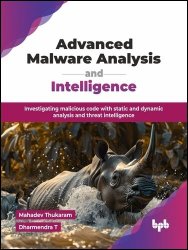 Название: Advanced Malware Analysis and Intelligence: Investigating malicious code with static and dynamic analysis and threat intelligence Название: Advanced Malware Analysis and Intelligence: Investigating malicious code with static and dynamic analysis and threat intelligence
Автор: Mahadev Thukaram, Dharmendra T
Издательство: BPB Publications
Год: 2025
Страниц: 460
Язык: английский
Формат: epub (true)
Размер: 10.1 MB
Advanced Malware Analysis and Intelligence teaches you how to analyze malware like a pro. Using static and dynamic techniques, you will understand how malware works, its intent, and its impact. The book covers key tools and reverse engineering concepts, helping you break down even the most complex malware.
This book is a comprehensive and practical guide to understanding and analyzing advanced malware threats. The book explores how malware is created, evolves to bypass modern defenses, and can be effectively analyzed using both foundational and advanced techniques. Covering key areas such as static and dynamic analysis, reverse engineering, malware campaign tracking, and threat intelligence, this book provides step-by-step methods to uncover malicious activities, identify IOCs, and disrupt malware operations. Readers will also gain insights into evasion techniques employed by malware authors and learn advanced defense strategies. It explores emerging trends, including AI and advanced attack techniques, helping readers stay prepared for future cybersecurity challenges.
By the end of the book, you will have acquired the skills to proactively identify emerging threats, fortify network defenses, and develop effective incident response strategies to safeguard critical systems and data in an ever-changing digital landscape.
In this book, we dive deep into both static and dynamic analysis techniques in Chapter 4 and Chapter 5, which are at the core of understanding how malware operates. Static analysis involves examining the malware without running it, while dynamic analysis looks at the behavior of malware in controlled environments. These chapters lay the foundation for understanding the intricate nature of malware, making them essential for advanced analysis. We also explore campaign analysis in Chapter 9, providing insights into how malware is distributed and maintained by attackers and how these campaigns can be tracked to prevent further incidents. Chapter 11 on incident response and remediation is also crucial, as it provides a structured approach for managing and mitigating the damage caused by malware attacks, helping organizations recover effectively.
Chapter 1: Understanding the Cyber Threat Landscape - This chapter introduces the constantly evolving cyber threat landscape, focusing on different types of cyber threats, their motivations, and the impact on individuals and organizations. It aims to provide you with a foundational understanding of the diverse nature of threats like malware, ransomware, and advanced persistent threats (APTs). By understanding the motivations behind these threats—be it financial gain, espionage, or disruption—you can better grasp the importance of advanced malware analysis as a critical tool in today’s cybersecurity landscape. This foundational knowledge sets the stage for diving deeper into more specific malware analysis techniques.
Chapter 2: Fundamentals of Malware Analysis - Provides a comprehensive introduction to the core concepts, techniques, and tools used in malware analysis. You will learn about different types of malware, such as viruses, worms, and Trojans, and gain insight into essential static and dynamic analysis techniques. This chapter also introduces tools like IDA Pro, Ghidra, and sandbox environments, which help in analyzing malware without executing it or by observing its behavior. These fundamentals are critical for understanding how malware operates, its potential impact, and how analysts can dissect its components to develop effective mitigation strategies...
Key Features:
- Covers everything from basics to advanced techniques, providing practical knowledge for tackling real-world malware challenges.
- Understand how to integrate malware analysis with threat intelligence to uncover campaigns, track threats, and create proactive defenses.
- Explore how to use indicators of compromise (IOCs) and behavioral analysis to improve organizational cybersecurity.
What you will learn:
- Gain a complete understanding of malware, its behavior, and how to analyze it using static and dynamic techniques.
- Reverse engineering malware to understand its code and functionality.
- Identifying and tracking malware campaigns to attribute threat actors.
- Identify and counter advanced evasion techniques while utilizing threat intelligence to enhance defense and detection strategies.
- Detecting and mitigating evasion techniques used by advanced malware.
- Developing custom detections and improving incident response strategies.
Who this book is for:
This book is tailored for cybersecurity professionals, malware analysts, students, and incident response teams. Before reading this book, readers should have a basic understanding of operating systems, networking concepts, any scripting language, and cybersecurity fundamentals.
Contents:
1. Understanding the Cyber Threat Landscape
2. Fundamentals of Malware Analysis
3. Introduction to Threat Intelligence
4. Static Analysis Techniques
5. Dynamic Analysis Techniques
6. Advanced Reverse Engineering
7. Gathering and Analysing Threat Intelligence
8. Indicators of Compromise
9. Malware Campaign Analysis
10. Advanced Anti-malware Techniques
11. Incident Response and Remediation
12. Future Trends in Advanced Malware Analysis and Intelligence
APPENDIX: Tools and Resources
Скачать Advanced Malware Analysis and Intelligence: Investigating malicious code with static and dynamic analysis
|